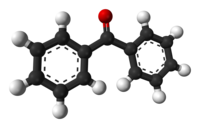Benzophenone
 |
|
 |
|
 |
|
| Names | |
|---|---|
|
Preferred IUPAC name
Diphenylmethanone
|
|
| Other names
Benzophenone
Phenyl ketone Diphenyl ketone Benzoylbenzene Benzoylphenyl Diphenylmethanone |
|
| Identifiers | |
|
3D model (Jmol)
|
|
| ChEBI | |
| ChemSpider | |
| DrugBank | |
| ECHA InfoCard | 100.003.943 |
| KEGG | |
|
PubChem CID
|
|
| UNII | |
|
|
|
|
| Properties | |
| C13H10O | |
| Molar mass | 182.22 g·mol−1 |
| Appearance | White solid |
| Odor | Geranium-like |
| Density | 1.11 g/cm3 |
| Melting point | 48.5 °C (119.3 °F; 321.6 K) |
| Boiling point | 305.4 °C (581.7 °F; 578.5 K) |
| Insoluble | |
| Solubility in organic solvents | 1 g/7.5 mL in ethanol 1 g/6 mL in diethyl ether |
| -109.6·10−6 cm3/mol | |
| Hazards | |
| Main hazards | Harmful (XN) |
| Safety data sheet | External MSDS by JT Baker |
| NFPA 704 | |
| Flash point | 110 °C (230 °F; 383 K) |
|
Except where otherwise noted, data are given for materials in their standard state (at 25 °C [77 °F], 100 kPa).
|
|
|
|
|
| Infobox references | |
Benzophenone is the organic compound with the formula (C6H5)2CO, generally abbreviated Ph2CO. Benzophenone is a widely used building block in organic chemistry, being the parent diarylketone.
Benzophenone can be used as a photo initiator in UV-curing applications such as inks, imaging, and clear coatings in the printing industry. Benzophenone prevents ultraviolet (UV) light from damaging scents and colors in products such as perfumes and soaps.
Benzophenone can also be added to plastic packaging as a UV blocker to prevent photo-degradation of the packaging polymers or its contents. Its use allows manufacturers to package the product in clear glass or plastic (such as a PETE water bottle). Without it, opaque or dark packaging would be required.
In biological applications, benzophenones have been used extensively as photophysical probes to identify and map peptide–protein interactions.
Benzophenone is produced by the copper-catalyzed oxidation of diphenylmethane with air.
A laboratory route involves the reaction of benzene with carbon tetrachloride followed by hydrolysis of the resulting diphenyldichloromethane. It can also be prepared by Friedel-Crafts acylation of benzene with benzoyl chloride in the presence of a Lewis acid (e.g. aluminium chloride) catalyst.
Another route of synthesis is through a palladium(II)/oxometalate catalyst. This converts an alcohol to a ketone with two groups on each side.
Another, less well-known reaction to produce benzophenone is the pyrolysis of anhydrous calcium benzoate.
Benzophenone is a common photosensitizer in . It crosses from the S1 state into the triplet state with nearly 100% yield. The resulting diradical will abstract a hydrogen atom from a suitable hydrogen donor to form a ketyl radical.
...
Wikipedia

